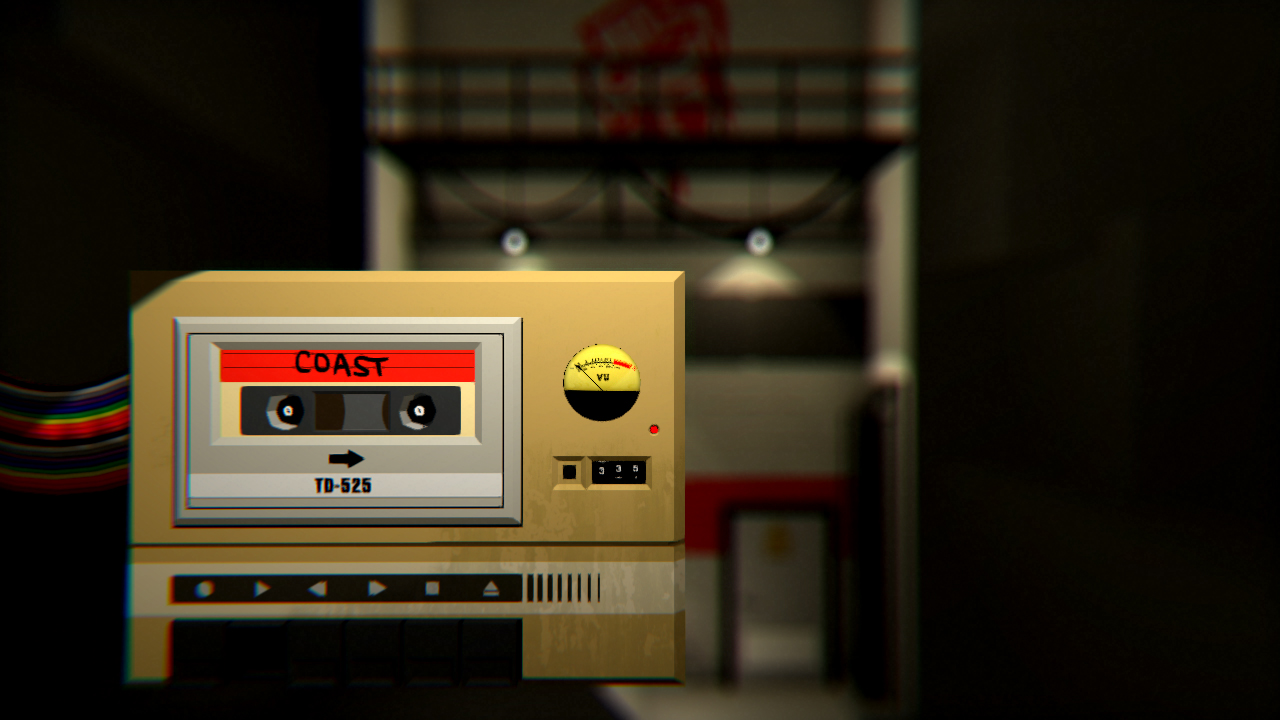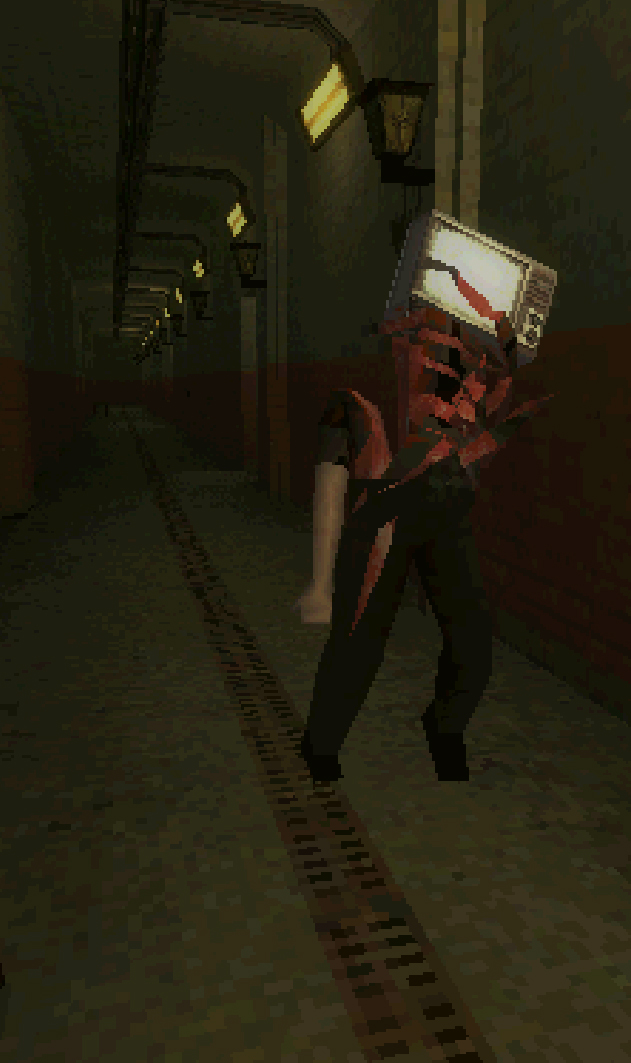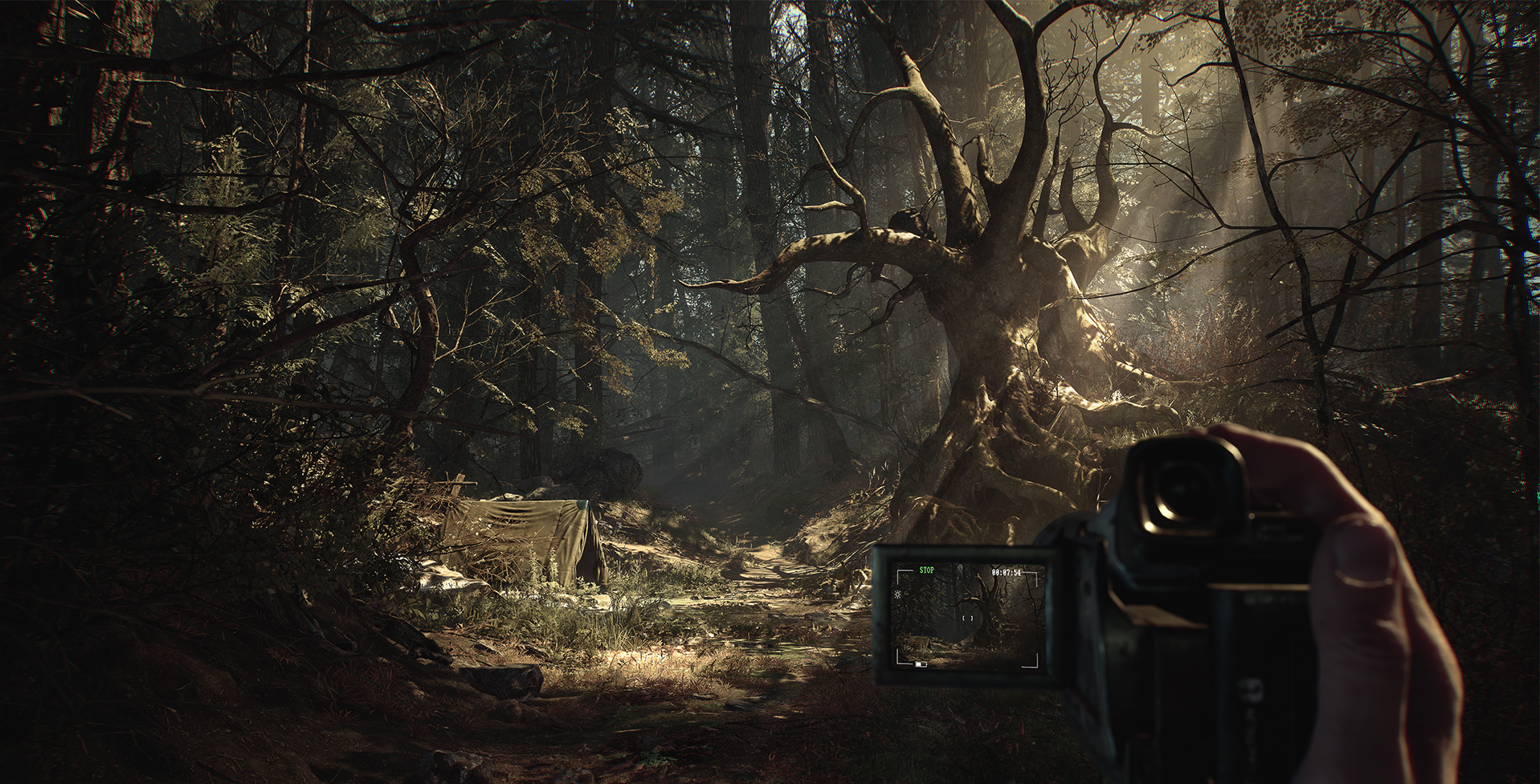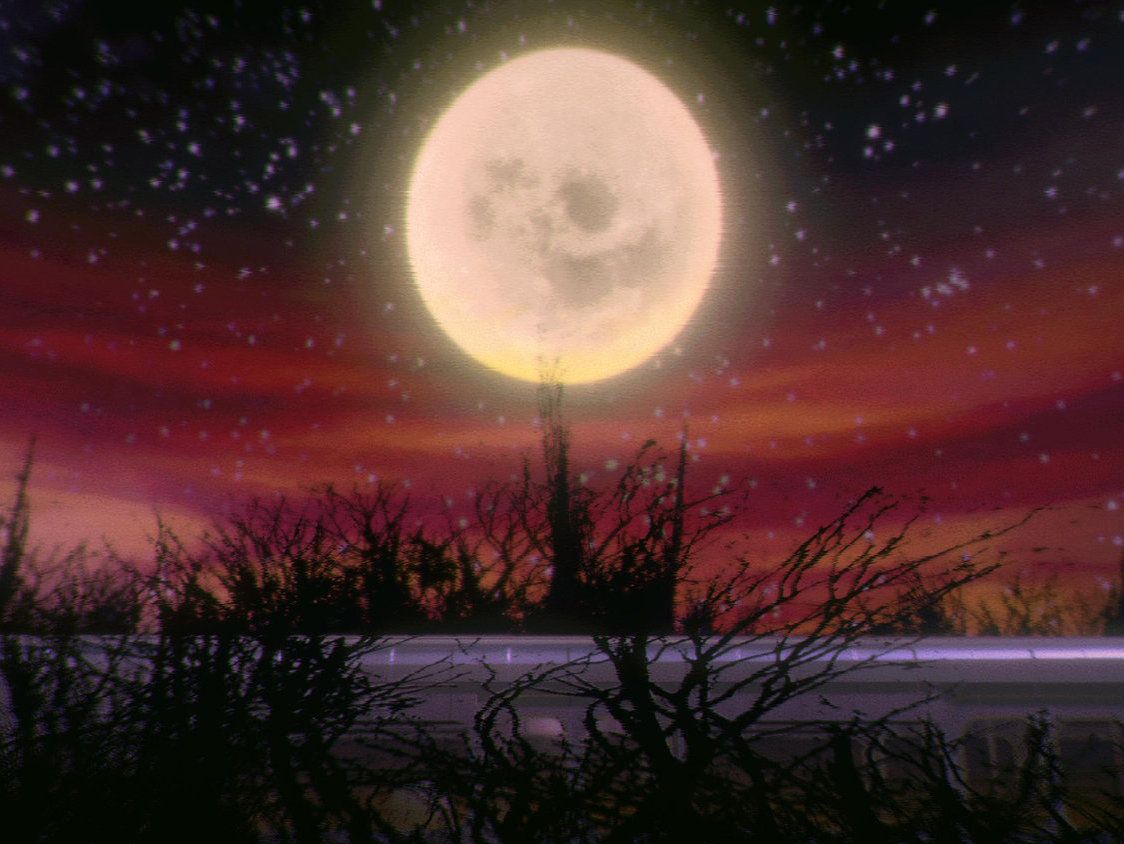The sound of static hums. Analog raindrops come and go on-screen. An image fades into view, but what it’s supposed to depict is unclear. You can see a date and time of day. Distorted figures appear within the frame, splashed by green and purple stains. A noise repeats in the background, but you can’t quite make out where it’s coming from. The sound grows louder and louder as the figures get closer to the camera. Now they have faces.
Small Radios Big Televisions pictures the aftermath of a world gone wrong. There isn’t a human in sight. In fact, your interactions with the game play out from a decidedly nonhuman perspective. From a pulled-back viewpoint, you spin around factory towers, clicking on doors to shift to an equally detached side view of the interior rooms. The puzzles within all center on seemingly abandoned machinery, all switches to flip and valves to turn.
But there are also cassette tapes scattered around, apparently serving as windows into what the world used to look like before. A big tree in a dark forest, leaves floating in the air with a black tint. A calm trip down a road in the middle of nowhere. Then, a shore that invites you to play with its pines, stretching them and distorting what seems to be one of the few remaining pieces of a lost memory. The problem is, there’s no way to prove that any of these scenes ever really existed.

Credit: Adult Swim Games
Tapes were a popular medium for distributing movies (and even some games) for decades, becoming commonplace throughout the ’80s and ’90s. Throughout the era, recorders became more affordable, and families began to capture their own memories for posterity. Aspiring movie makers toyed around with the new possibilities opened up by this technological democratization. By 2016, when the last company manufacturing VHS tapes, Funai, ceased production, the format had been around for 40 years.
In our age of Photoshop and deepfakes, we tend to think of digital media as uniquely corruptible and easily manipulated, but physical media wasn’t infallible, either. Even before hundreds of digital tools for modifying recordings, analog videos could also be altered, subverting the snapshots of reality they purported to hold. Nature, too, is a video editor: The passage of time, with the help of humidity and high temperatures, undermines the magnetic organization of a videotape, modifying both image and sound.
It’s these juxtapositions—between the inherent credibility of analog media and the sense it might be deceiving you, and between intentional corruption and organic decay—that make tapes such fertile ground for video games, especially those that seek to unsettle or frighten us. Dillon Rogers, the developer behind the survival horror title Gloomwood, has argued on Twitter that “the compression and physical corruption of VHS makes it a flexible aesthetic for horror.”
Small Radios Big Televisions is not, strictly speaking, a horror game. But its reliance on analog tapes and the way they shift over time lend an unsettling quality to the experience. You can only progress through puzzles by manipulating the cassette tapes you discover. When you play them, you become a temporary prisoner of whatever reality they contain, rewinding and distorting the world around you, clicking to collect hidden gems and other items you’ll need to slot into the sterile world of the factories. Once you find what you need, you’re free to stop the tapes and forget they exist. But it’s also possible to disrupt them even further by using magnetic fields—so much so that any sense they’re connected to real events has been worn away.

Credit: Arbitrary Metric
The three faces look at you for a moment, quiet. The sound in the background is gone. They begin to talk, but you don’t understand them. Maybe they don’t want to be heard. Snapshots pass by. The tree in the forest. The road. A shore covered with pines. You’re afraid to rewind. Suddenly, the three figures return. One of them is carrying a gun.
An assassin. A birdwatcher. A smuggler. Paratopic lets you see through the eyes of three different individuals, each tangled in their own tale of horror and regret. At less than an hour, it’s an eerie trip that jumps in between abrupt camera cuts, taking you through scenes that don’t make much sense during your first playthrough. You sit in a diner talking with a man whose face gets closer with every dialogue transition. You open doors to forbidden places. You discover a briefcase filled with VHS tapes, the object of a mysterious and unhealthy obsession among the people you encounter.
“Don’t watch the tapes,” was a tagline often repeated as part of developer Arbitrary Metric’s social media campaign. At first, it sounded like it was merely an inside joke for those who played Paratopic. But once I got my hands on the game, I finally understood its meaning. It was a warning.
I walk down the corridor of a decaying motel. Smoke fills the air. A woman greets me, saying there’s something waiting for me in my room. It’s a black case with a white symbol on top. Once I open the lock, I can see what’s inside. The woman’s voice returns, behind me now.

Credit: Arbitrary Metric
“It’s tapes, isn’t it,” she says.
“Oh! Uh… you need something?” I ask.
“Need another one.”
“I shouldn’t.”
“Fuck you. What’s stopping you this time?”
“I didn’t know.”
I give her another tape. It’s a mistake. A short scene shows the woman sitting alone in her room, accompanied by the sound of static. Her face unfolds like a flower. Then, suddenly, I’m miles away, on the other side of another jump cut.
VHS tapes are uncertain artifacts. You can choose to trust their homemade, pen-scrawled labels, but without playing them, there’s no real way of knowing what they contain or what state that information is in. Paratopic plays with this uncertainty from the very beginning. The woman is obsessed with the tapes, and the dialogue suggests that she somehow consumes them. They become a drug of sorts, each more inviting than the last. Slowly, you also become curious to know what’s inside, to understand why they’re so alluring.
In another scene, after a killer commits a murder inside the diner, you’re faced with a table covered in a pile of tapes and a working TV with VCR. Tape by tape, the murder scene is recreated, forcing you into a loop. Time and time again, the victim gets shot and his body falls to the floor, his white shirt stained with blood. It’s almost as if the whole memory was rewinding itself inside your head, over and over. One tape takes you out of the trance, but it’s not for the better. The sequence that follows is even more terrifying.
You see a man with his dog in a forest. At first they’re merely walking. But in between camera cuts, you witness them in different situations. Some are more recognizable than others. There’s a sense of familiarity in these scenes as you rewind them. Once you start watching the footage again, things that weren’t there in the first place now appear. The dog barks, echoing inside an empty cabin. A body lays on the floor. Shadows flirt about outside.
1999’s The Blair Witch Project was one of the first movies that kicked off the “found footage” horror genre and showcased the horror potential of VHS tapes. Three students travel to the Black Hills of Maryland to investigate the local legend of a spirit linked to centuries of mysterious occurrences. Unfortunately for our heroes, this urban legend turns out to be true. This story played into how the film itself was promoted. Ostensibly, this wasn’t a fictional story being told in the present, but genuine found footage discovered a year after the events depicted. The material is raw and sometimes confusing, and at times you do start to question if what you’re seeing might be real. That ambiguity is at the heart of The Blair Witch Project’s popularity. It’s the thought of finding a real tape like this in the middle of nowhere that’s so unnerving.
Bloober Team’s Blair Witch doesn’t quite recreate this feeling. The 2019 game relies a bit too much on jump scares to recapture what made the first movie so appealing. Where it shines, however, is in the way it treats recordings. Much like in Small Radios Big Televisions, your progress depends on extracting what you need from the tapes. In Blair Witch, this means rewinding the footage to the point where the past aligns with the present, shifting your perspective and uncovering objects that weren’t there before.

Credit: Lionsgate Games
But these manipulations of time and space also raise new questions. Having the power to fix broken paths or to create pieces out of thin air through a recording leads you to doubt that what you’re seeing is entirely real within the context of the game. Much like in the movie, there’s no way to know the whole truth. As viewers, it’s all a matter of suspension of disbelief. As players, these unanswered questions carry more weight, since you feel part of that footage lost in time as well.
“In this era too, there was now video access to things from all over the world, cryptids from South America or Southeast Asia were now at your fingertips, and it was easy to chalk anything too strange up to ‘movie magic’ or CGI,” rebind.io founder Emily Rose tweeted in July. “Deep down you knew you weren’t sure.”
Elsewhere in the same thread, Rose noted that “‘weird video tapes’ is the domain of the archivist, the small town video rental store, or the repo man. Weird compressed, ambiguous digital yet lacking fidelity? That’s the domain of the mortified dude in his parent’s living room at night, unaware of the specter at his window.”
From the forest into an urban landscape. Remnants of a home, a train, a festival in town. Purple, green. And, without fail, the rain. Colors flashes through the eyes of the window, following the rhythm of the tracks. White and grey waves of sound appear as tangible objects, stretching themselves from the walls and blocking corridors. It seems like the tape is about to end.
Many other games play with these analog memories, exploring their horror potential in a digital landscape—always distorted, never entirely legible. Resident Evil 7, for instance, employs both cassette tapes for saving your progress and VHS tapes as collectibles that allow you to experience the perspective of another character. The video message that kicks off the story, sending protagonist Ethan to the Baker house in search of his wife, may be recorded digitally on a laptop webcam, but it’s anachronistically adorned with the elements of a camcorder: a battery meter, a flashing “record” symbol.

Credit: Colorfiction
Colorfiction’s upcoming Ode to a Moon aims to create a reality that’s already distorted. Everything you do, see, and feel happens inside a tape. You’re a journalist tasked with covering the events of a rural harvest festival, a celebration that used to take place every summer until something changed. Psychedelic overtones make the contents of the tape feel unreal, even for a fictional work. And yet, it’s difficult to shake that sense of analog credibility, the idea that the tape only exists because someone recorded it.
It’s the same sense of uncertainty and disruption that unites these tapes. Some use the medium to grant you control over time and space. Others rob you of that same power through jarring dislocation. Sometimes the identity of the figure who recorded the tape and the one watching it are both clear. Sometimes both individuals are shrouded in mystery. But in every case, your sense of reality becomes confused, coiled around truth and untruth like a tightly wound magnetic tape kept isolated from the world in its plastic housing.
There it is. The sound of static. Analog raindrops coming and going on-screen. A date and time. And a repeating noise in the background, becoming louder and louder as figures begin to appear.
Some quotes have been lightly edited for clarity.
Header image credit: Paratropic, Arbitrary Metric

Freelance journalist from Argentina. Frustrated bassist. Learned English thanks to video games. He runs Into The Spine, a site that hosts stories around games and what they leave behind, along with supporting both upcoming and established writers. He’s probably listening to music right now, or procrastinating on Twitter.